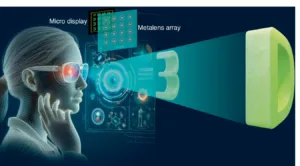Researchers have developed an augmented reality (AR) technology. The authors introduce a prototype that utilizes an ultrathin nanoimprint metalens array to create a see-through augmented reality display. This display system offers full-color, video-rate, and low-cost 3D visualization, addressing key limitations of previous AR systems.

The research team from Sun Yat-sen University introduced its findings in the form of a large-scale nanoimprint metalens array integrated with a microdisplay and a real-time rendering algorithm. The sophisticated real-time rendering algorithm generrates high-quality 3D images with motion parallax and focus cues.
Integral imaging (II) display, an established technique for creating 3D images, forms the basis of this technology. II display captures and reproduces the light field of a scene using a lens/pinhole array. Unlike holography, II display does not require coherent light sources and offers advantages like full parallax and reduced visual fatigue.
The heart of the device is the nanoimprint metalens array, which consists of an array of tiny metalenses. These metalenses are designed to manipulate light at a subwavelength scale, allowing precise control over properties such as amplitude, phase, polarization, and dispersion of transmitted or reflected light. They address issues like chromatic aberration encountered by traditional microlens arrays.
While nanoimprint lithography and real-time rendering algorithms hold promise for advancing II displays in VR and AR applications, several challenges persist. Acquiring high-resolution images remains difficult, requiring micro-display sensors with ultra-small pixel sizes, which are challenging to manufacture. Time-multiplexed light fields with high refresh rate monitors may offer a solution to this issue. Additionally, the low refractive index of available nanoimprint adhesives necessitates high-aspect-ratio nanopillars for building metalenses, resulting in a shadowing effect that reduces diffraction efficiency at high spatial frequencies.
Developing truly interactive 3D displays requires dynamic metasurfaces for fast tunability and low power consumption. Although mechanisms like phase change and the electro-optic effect have been proposed for dynamic metasurfaces, this area is still in its early stages of development. Metasurfaces’ unique ability to interact with multiple light degrees of freedom, such as polarization, wavelength, orbital angular momentum, and spatiotemporal beams, could enhance the dynamic function and image capacity of metasurface-based displays further.
In addition to hardware challenges, software aspects of future 3D display technology could benefit from rapid developments in machine learning, neural networks, and artificial intelligence. These advancements hold potential for addressing software-related complexities in creating immersive 3D visualizations.
Reference
Li, C., Ren, H. Beyond the lab: a nanoimprint metalens array-based augmented reality. Light Sci Appl 13, 102 (2024). https://doi.org/10.1038/s41377-024-01429-x

